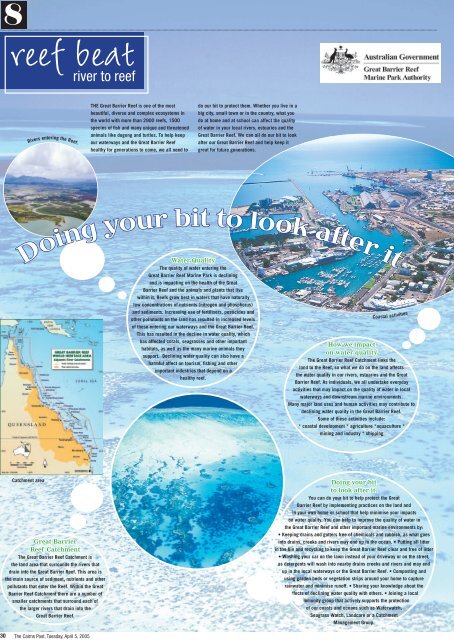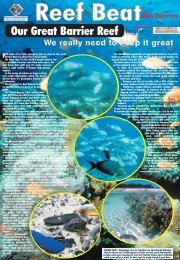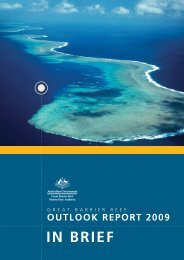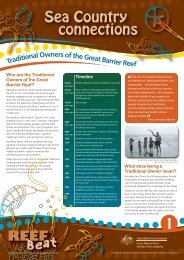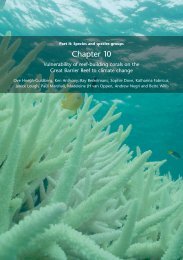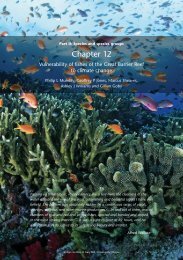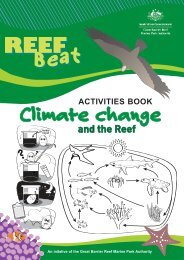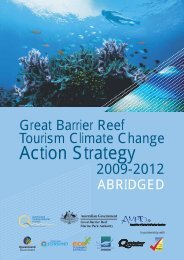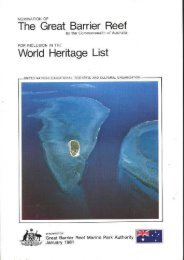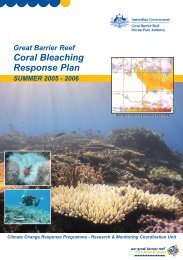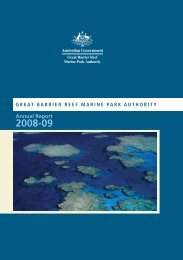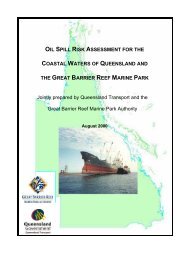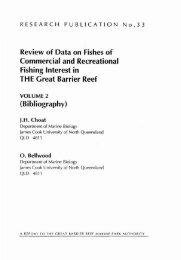2005 Reef Beat posters 1-8 in Cairns Post.pdf - Great Barrier Reef ...
2005 Reef Beat posters 1-8 in Cairns Post.pdf - Great Barrier Reef ...
2005 Reef Beat posters 1-8 in Cairns Post.pdf - Great Barrier Reef ...
- No tags were found...
You also want an ePaper? Increase the reach of your titles
YUMPU automatically turns print PDFs into web optimized ePapers that Google loves.
8reef beatriver to reefRivers enter<strong>in</strong>g the <strong>Reef</strong>.THE <strong>Great</strong> <strong>Barrier</strong> <strong>Reef</strong> is one of the mostbeautiful, diverse and complex ecosystems <strong>in</strong>the world with more than 2900 reefs, 1500species of fi sh and many unique and threatenedanimals like dugong and turtles. To help keepour waterways and the <strong>Great</strong> <strong>Barrier</strong> <strong>Reef</strong>healthy for generations to come, we all need todo our bit to protect them. Whether you live <strong>in</strong> abig city, small town or <strong>in</strong> the country, what youdo at home and at school can affect the qualityof water <strong>in</strong> your local rivers, estuaries and the<strong>Great</strong> <strong>Barrier</strong> <strong>Reef</strong>. We can all do our bit to lookafter our <strong>Great</strong> <strong>Barrier</strong> <strong>Reef</strong> and help keep itgreat for future generations.itafter look bit to your Do<strong>in</strong>gWater QualityThe quality of water enter<strong>in</strong>g the<strong>Great</strong> <strong>Barrier</strong> <strong>Reef</strong> Mar<strong>in</strong>e Park is decl<strong>in</strong><strong>in</strong>gand is impact<strong>in</strong>g on the health of the <strong>Great</strong><strong>Barrier</strong> <strong>Reef</strong> and the animals and plants that livewith<strong>in</strong> it. <strong>Reef</strong>s grow best <strong>in</strong> waters that have naturallylow concentrations of nutrients (nitrogen and phosphorus)and sediments. Increas<strong>in</strong>g use of fertilisers, pesticides andother pollutants on the land has resulted <strong>in</strong> <strong>in</strong>creased levelsof these enter<strong>in</strong>g our waterways and the <strong>Great</strong> <strong>Barrier</strong> <strong>Reef</strong>.This has resulted <strong>in</strong> the decl<strong>in</strong>e <strong>in</strong> water quality, whichhas affected corals, seagrasses and other importanthabitats, as well as the many mar<strong>in</strong>e animals theysupport. Decl<strong>in</strong><strong>in</strong>g water quality can also have aharmful affect on tourism, fi sh<strong>in</strong>g and otherimportant <strong>in</strong>dustries that depend on ahealthy reef.Coastal activitiesHow we impacton water qualityThe <strong>Great</strong> <strong>Barrier</strong> <strong>Reef</strong> Catchment l<strong>in</strong>ks theland to the <strong>Reef</strong>, so what we do on the land affectsthe water quality <strong>in</strong> our rivers, estuaries and the <strong>Great</strong><strong>Barrier</strong> <strong>Reef</strong>. As <strong>in</strong>dividuals, we all undertake everydayactivities that may impact on the quality of water <strong>in</strong> localwaterways and downstream mar<strong>in</strong>e environments.Many major land uses and human activities may contribute todecl<strong>in</strong><strong>in</strong>g water quality <strong>in</strong> the <strong>Great</strong> <strong>Barrier</strong> <strong>Reef</strong>.Some of these activities <strong>in</strong>clude:* coastal development * agriculture *aquaculture *m<strong>in</strong><strong>in</strong>g and <strong>in</strong>dustry * shipp<strong>in</strong>gCatchment area<strong>Great</strong> <strong>Barrier</strong><strong>Reef</strong> CatchmentThe <strong>Great</strong> <strong>Barrier</strong> <strong>Reef</strong> Catchment isthe land area that surrounds the rivers thatdra<strong>in</strong> <strong>in</strong>to the <strong>Great</strong> <strong>Barrier</strong> <strong>Reef</strong>. This area isthe ma<strong>in</strong> source of sediment, nutrients and otherpollutants that enter the <strong>Reef</strong>. With<strong>in</strong> the <strong>Great</strong><strong>Barrier</strong> <strong>Reef</strong> Catchment there are a number ofsmaller catchments that surround each ofthe larger rivers that dra<strong>in</strong> <strong>in</strong>to the<strong>Great</strong> <strong>Barrier</strong> <strong>Reef</strong>.Do<strong>in</strong>g your bitto look after it.You can do your bit to help protect the <strong>Great</strong><strong>Barrier</strong> <strong>Reef</strong> by implement<strong>in</strong>g practices on the land and<strong>in</strong> your own home or school that help m<strong>in</strong>imise your impactson water quality. You can help to improve the quality of water <strong>in</strong>the <strong>Great</strong> <strong>Barrier</strong> <strong>Reef</strong> and other important mar<strong>in</strong>e environments by:• Keep<strong>in</strong>g dra<strong>in</strong>s and gutters free of chemicals and rubbish, as what goes<strong>in</strong>to dra<strong>in</strong>s, creeks and rivers may end up <strong>in</strong> the ocean. • Putt<strong>in</strong>g all litter<strong>in</strong> the b<strong>in</strong> and recycl<strong>in</strong>g to keep the <strong>Great</strong> <strong>Barrier</strong> <strong>Reef</strong> clear and free of litter• Wash<strong>in</strong>g your car on the lawn <strong>in</strong>stead of your driveway or on the street,as detergents will wash <strong>in</strong>to nearby dra<strong>in</strong>s creeks and rivers and may endup <strong>in</strong> the local waterways or the <strong>Great</strong> <strong>Barrier</strong> <strong>Reef</strong>. • Compost<strong>in</strong>g andus<strong>in</strong>g garden beds or vegetation strips around your home to capturera<strong>in</strong>water and m<strong>in</strong>imise runoff. • Shar<strong>in</strong>g your knowledge about theeffects of decl<strong>in</strong><strong>in</strong>g water quality with others. • Jo<strong>in</strong><strong>in</strong>g a localcommunity group that actively supports the protectionof our coasts and oceans such as Waterwatch,Seagrass Watch, Landcare or a CatchmentManagement Group.30 The <strong>Cairns</strong> <strong>Post</strong>, Tuesday, April 5, <strong>2005</strong>
8reef beatriver to reefconnected!all It’sThe <strong>Great</strong> <strong>Barrier</strong> <strong>Reef</strong>.A crucial habitat.Keep<strong>in</strong>g the <strong>Reef</strong> clean will ensure the future of its occupants.IF you’re a person on a cattle property ona hot dry day <strong>in</strong> <strong>in</strong>land Queensland, thelast th<strong>in</strong>g to enter your m<strong>in</strong>d could verywell be the beauty and health of the <strong>Great</strong><strong>Barrier</strong> <strong>Reef</strong>.However, you may not realise that someof the th<strong>in</strong>gs we do on the land, even <strong>in</strong> theoutback, can impact on the <strong>Reef</strong> and itsseagrass, coral and mangrove habitats.All of our land and mar<strong>in</strong>e environmentsand habitats are l<strong>in</strong>ked, so what we do <strong>in</strong> oneplace can damage or help another place.That’s why communities, <strong>in</strong>dustries,governments and scientists are work<strong>in</strong>gtogether on ways to reduce the effects of ouractivities on the <strong>Great</strong> <strong>Barrier</strong> <strong>Reef</strong>.IN THE PASTEuropean settlers came to Australia, theycleared large areas of the land to make roomfor towns to be built, for cattle to graze andfor crops to grow.When vegetation is removed and heavyra<strong>in</strong> falls, a lot of the good topsoil and itsnatural nutrients are washed away <strong>in</strong>torivers, creeks and out to sea. Withoutvegetation <strong>in</strong> these areas, there is noth<strong>in</strong>g tohold the soil together, so more nutrients andsediments are discharged to our waterwaysand the <strong>Great</strong> <strong>Barrier</strong> <strong>Reef</strong>.With the establishment of many townsand cities along the coast, more nutrientsand other pollutants and rubbish <strong>in</strong>clud<strong>in</strong>gplastic bags have found their way <strong>in</strong>tothe environment.In some areas, chemicals and nutrientsthat are used <strong>in</strong> homes and to help growcrops also wash <strong>in</strong>to the rivers and out <strong>in</strong>tothe <strong>Great</strong> <strong>Barrier</strong> <strong>Reef</strong>.Many farmers and city dwellers are nowth<strong>in</strong>k<strong>in</strong>g of new ways to reduce their impactson the <strong>Great</strong> <strong>Barrier</strong> <strong>Reef</strong>.PROTECTING IMPORTANT HABITATSIf we want to protect our magnifi cent <strong>Great</strong><strong>Barrier</strong> <strong>Reef</strong>, we need to look after all thehabitats with<strong>in</strong> and surround<strong>in</strong>g it.all It’s connected!The primary habitats to th<strong>in</strong>k about arewetlands, mangroves, seagrass areas andsoft bottom <strong>in</strong>ter-reefal areas.Mangroves are important to the life of the<strong>Great</strong> <strong>Barrier</strong> <strong>Reef</strong> because they can act asnurseries for baby fi sh and prawns that latergrow up and move out to the reefs.They are also home to a large range of birdlife and they act as a buffer between the landand the sea.Seagrasses are also nursery areas andare where the endangered dugongs fi ndtheir food. Some sea turtles also depend onseagrass for their meals.These areas are where we fi nd animalslike seahorses and pipefi sh.Other habitats most people don’t th<strong>in</strong>kabout are the soft bottom <strong>in</strong>ter-reefal areas.They’re called soft bottomed because theyhave mud or sand on the seafl oor. Theseareas are where fi shers catch prawns.Inter-reefal areas are also home toan <strong>in</strong>credibly diverse group of animalsand plants.DOING YOUR BIT TO LOOK AFTER IT!If we act carelessly and pollute our landand streams we can damage our <strong>Great</strong><strong>Barrier</strong> <strong>Reef</strong>, seagrasses and mangrovesbeyond repair.We have to be very careful about how wedispose of rubbish and other toxic materialsand how we use our land.One of the th<strong>in</strong>gs we can do is to alwaysbe m<strong>in</strong>dful about what we put <strong>in</strong>to our dra<strong>in</strong>sand sewers.Even wash<strong>in</strong>g your car <strong>in</strong> the street ordriveway can result <strong>in</strong> detergents enter<strong>in</strong>gour waterways and every time you poursometh<strong>in</strong>g down the s<strong>in</strong>k, it may end upreach<strong>in</strong>g the <strong>Great</strong> <strong>Barrier</strong> <strong>Reef</strong>.The seabed is alive with plants and creatures.30 The <strong>Cairns</strong> <strong>Post</strong>, Tuesday, April 12, <strong>2005</strong>
8Wetlands- an oasis of lifereef beatriver to reefWetlands arepeaceful placesof great beauty.WETLANDS are amaz<strong>in</strong>gand complex waterwaysthat occur <strong>in</strong> manydifferent sizes and forms.Wetlands are land areas eithertemporarily or permanently coveredby water. Types of wetlands <strong>in</strong>cludeswamps, marshes, billabongs,saltmarshes, mudflats, coral reefs,mangroves, lakes and peatlands.Mar<strong>in</strong>e habitats like coral reefs,seagrass meadows, mudflats,mangrove estuaries, samphire saltmarshes, rocky mar<strong>in</strong>e shores andsand or pebble beachesare common forms ofmar<strong>in</strong>e wetlands found<strong>in</strong> and around the <strong>Great</strong><strong>Barrier</strong> <strong>Reef</strong>.Wetlands are oftenareas of great beautywhere people enjoythe scenery and gatherfor recreation.In all their forms, wetlands arevery special places.THE IMPORTANCE OF WETLANDSWetlands <strong>in</strong> catchments alongthe coast next to the <strong>Great</strong> <strong>Barrier</strong><strong>Reef</strong> Mar<strong>in</strong>e Park are vital for thelong-term protection of the <strong>Great</strong><strong>Barrier</strong> <strong>Reef</strong>.Wetlands support a diverserange of mar<strong>in</strong>e life and providehabitat, breed<strong>in</strong>g and nurseryareas for birds, mammals, reptiles,amphibians, <strong>in</strong>sects and many fishspecies such as barramundi andmangrove jack.Wetlands play an important role<strong>in</strong> protect<strong>in</strong>g water quality <strong>in</strong> the<strong>Great</strong> <strong>Barrier</strong> <strong>Reef</strong> Mar<strong>in</strong>e Parkby help<strong>in</strong>g to filter the sediment,nutrients and other pollutants fromthe waters that enter the <strong>Great</strong><strong>Barrier</strong> <strong>Reef</strong>.They are also important <strong>in</strong>:• prevent<strong>in</strong>g erosion• allow<strong>in</strong>g sediments and nutrientsto settle out before enter<strong>in</strong>g the<strong>Great</strong> <strong>Barrier</strong> <strong>Reef</strong>• protect<strong>in</strong>g the coastl<strong>in</strong>e fromerosion and dur<strong>in</strong>g destructiveevents such as cyclones.Wetlands are significant habitatsfor Aborig<strong>in</strong>al and Torres StraitIslanders as part of their culturalheritage, spiritual values andday-to-day liv<strong>in</strong>g. Wetlands alsoprovide for recreational andtourism opportunities such asfish<strong>in</strong>g and guided tours.Wetlands on farms buffer theeffects of floods by hold<strong>in</strong>g excesswater for a short time, reduc<strong>in</strong>g theseverity of flood<strong>in</strong>g downstream.Wetlands provide diverse habitatsfor plants, birds and animals, manyof which feed on agricultural pests.Wetlands also make a farm a more<strong>in</strong>terest<strong>in</strong>g and pleasant place forpeople to work and live and theyprovide for added recreationalopportunities such as fish<strong>in</strong>g.WETLANDS IN DANGERMore than 50 per cent of ourwetlands have been significantlyaffected through degradation or losss<strong>in</strong>ce European settlement.Catchments adjacent to the<strong>Great</strong> <strong>Barrier</strong> <strong>Reef</strong> have beenextensively cleared and modifiedfor urban development, aquaculturedevelopment and agriculturalactivities such as cattle graz<strong>in</strong>gand cropp<strong>in</strong>g.PROTECTING WETLANDSThe protection of wetlands iscritical to help ensure the survivalof the <strong>Great</strong> <strong>Barrier</strong> <strong>Reef</strong>.The preservation andrehabilitation of wetland areas isa major environmental priorityfor the Australian and QueenslandGovernment’s <strong>Reef</strong> Water QualityProtection Plan.Communities, <strong>in</strong>dustries andgovernments are work<strong>in</strong>g togetherto raise awareness of the effects ofwetland clear<strong>in</strong>g and to help protectwetland areas for the future.A number of communityprojects have been developed tohelp prevent the decl<strong>in</strong>e of theseimportant environments.For <strong>in</strong>formation about how youcan become <strong>in</strong>volved <strong>in</strong> a wetlandprotection project <strong>in</strong> your area,contact your local Council or yourlocal Regional Natural ResourceManagement Group at http://regionalnrm.qld.gov.au/about/regional.DOING THEIR BIT TO LOOK AFTER ITMany communities andfarmers are work<strong>in</strong>g together torehabilitate and revegetate naturalenvironments like wetlands.By revegetat<strong>in</strong>g riverbanks,wetlands and other areas aroundtheir farms, land managers arehelp<strong>in</strong>g to decrease the amountof nutrients and sediments thatare discharged <strong>in</strong>to surround<strong>in</strong>gwaterways and <strong>in</strong> turn are help<strong>in</strong>gto improve the quality of water <strong>in</strong>the <strong>Great</strong> <strong>Barrier</strong> <strong>Reef</strong>.These actions will help to ensurethe survival of the <strong>Great</strong> <strong>Barrier</strong><strong>Reef</strong> and all of the habitats,plants, animals and <strong>in</strong>dustriesit supports.The wetlands are a haven for diversity.Mar<strong>in</strong>e life relies heavily on the prist<strong>in</strong>ewetlands for survival.30 The <strong>Cairns</strong> <strong>Post</strong>, Tuesday, April 19, <strong>2005</strong>
8reef beatriver to reefALL plants and animals& nutrients are What sediments?need nutrients to grow, however <strong>in</strong>excessive amounts nutrients can be harmfulto mar<strong>in</strong>e life. There are two ma<strong>in</strong> types of nutrientsnitrogen and phosphorous and these exist <strong>in</strong> several forms<strong>in</strong> mar<strong>in</strong>e waters. Other types of nutrients <strong>in</strong>clude potassiumand sulphur. Sediments are fi ne particles of soil, sand and otherm<strong>in</strong>erals or organic matter that is eroded from land and carried <strong>in</strong>surface waters. Sediment occurs naturally <strong>in</strong> the <strong>Great</strong> <strong>Barrier</strong> <strong>Reef</strong>,however human activities and land uses have caused excessiveamounts of sediments to be discharged to the <strong>Reef</strong>. Around fourtimes as much sediments and nutrients are nowdischarged to the <strong>Great</strong> <strong>Barrier</strong> <strong>Reef</strong> asoccurred before settlement.NUTRIENTS enterthe mar<strong>in</strong>e environment throughcreeks, rivers and estuaries. A largeamount of nutrients are discharged to the <strong>Great</strong><strong>Barrier</strong> <strong>Reef</strong> dur<strong>in</strong>g floods, but they can also bedischarged to the <strong>Reef</strong> at all times of the year throughrun-off, wastewater, stormwater and sewage discharge.How do they reach the <strong>Great</strong> <strong>Barrier</strong> <strong>Reef</strong>?How do they reach the <strong>Great</strong> <strong>Barrier</strong> <strong>Reef</strong>?Human activities such as urban development, agricultureand aquaculture are all contributors of sediment andnutrient discharges to the <strong>Great</strong> <strong>Barrier</strong> <strong>Reef</strong>. Themost common way for sediment to reach thewaters of the <strong>Great</strong> <strong>Barrier</strong> <strong>Reef</strong> is throughrun-off and soil erosion.EXCESSIVE <strong>in</strong>putsof sediment from the landto the <strong>Great</strong> <strong>Barrier</strong> <strong>Reef</strong> can lead toreef destruction through burial, disruptionof breed<strong>in</strong>g habits and harmful shifts <strong>in</strong> coralcommunities. Sediment affects coral by •smother<strong>in</strong>gthem when particles settle out (sedimentation)• reduc<strong>in</strong>g light availability (turbidity) • potentiallyreduc<strong>in</strong>g coral photosynthesis and growth. Elevatedsediment and nutrient concentrations <strong>in</strong> severe fl oodscan even be harmful to seagrass beds as they cancause a dramatic reduction of light availability,which limits the seagrasses ability toPRIOR tomanufacture food.European settlement over150 years ago, the <strong>Great</strong> <strong>Barrier</strong><strong>Reef</strong> was not nutrient rich. Coralsprefer to live <strong>in</strong> waters with low amountsof nutrients and sediments, as theyneed clear water and sunlight to survive.The excess nutrients and sedimentsrunn<strong>in</strong>g <strong>in</strong>to our waterways and the<strong>Great</strong> the on <strong>Barrier</strong> impact reef?they do How<strong>Great</strong> <strong>Barrier</strong> <strong>Reef</strong> are impact<strong>in</strong>g onthe health of reefs and otherimportant habitats.sedimentsof Impactsnutrientsof ImpactsHIGH nutrientconcentrations result <strong>in</strong> a rangeof impacts on coral communities and underextreme situations can cause coral reef communitiesto collapse. Excess nutrients <strong>in</strong> the <strong>Great</strong> <strong>Barrier</strong> <strong>Reef</strong>contribute to decl<strong>in</strong><strong>in</strong>g water quality and can severely harmcorals by: • promot<strong>in</strong>g phytoplankton (microscopic float<strong>in</strong>g plants)growth, which <strong>in</strong> turn supports <strong>in</strong>creased numbers of fi lter feed<strong>in</strong>gorganisms such as tubeworms, sponges and bivalves that competewith coral for space • caus<strong>in</strong>g macroalgal blooms, which mayovergrow coral structures, out-compet<strong>in</strong>g coral for space andshad<strong>in</strong>g coral colonies from sunlight • caus<strong>in</strong>g excessivephosphorus concentrations, which weakens the skeletonsof hard corals • <strong>in</strong>hibit<strong>in</strong>g breed<strong>in</strong>g <strong>in</strong> somecoral species and reduc<strong>in</strong>g recruitment tothe population.YOU can do yourbit to help decrease theamount of nutrients and sedimentsenter<strong>in</strong>g the <strong>Great</strong> <strong>Barrier</strong> <strong>Reef</strong> by • Us<strong>in</strong>git!after look to bit your Do<strong>in</strong>gphosphate-free and biodegradable products• Plant<strong>in</strong>g ground cover and trees over areaswith exposed soil • Plant<strong>in</strong>g garden bedsand vegetation strips around your yardor school grounds to help m<strong>in</strong>imiserun off.30 The <strong>Cairns</strong> <strong>Post</strong>, Tuesday, April 26, <strong>2005</strong>
8reef beatriver to reefsomewhere!goes all ItMany daily activities have the potential to upset thedelicate ecological balance of our waterways.When <strong>in</strong> thewater, try not toWhether you live <strong>in</strong> a major city, smalltown or <strong>in</strong> the country, what you doat home, work and school <strong>in</strong> thegraz<strong>in</strong>g and cropp<strong>in</strong>g.To make space for these agriculturalactivities, large areas of native vegetation havestir up sedimentor disturb coral.<strong>Great</strong> <strong>Barrier</strong> <strong>Reef</strong> catchment can affect thebeen cleared. This, along with over-stock<strong>in</strong>g onquality of water <strong>in</strong> the <strong>Reef</strong>.farms, has caused widespread soil erosion <strong>in</strong>Many of your daily activities may <strong>in</strong>crease thelevels of nutrients, sediments and chemicalsbe<strong>in</strong>g discharged to the <strong>Great</strong> <strong>Barrier</strong> <strong>Reef</strong>.FROM THE CITY TO THE SEANutrients, sediments and other pollutants canreach our <strong>Great</strong> <strong>Barrier</strong> <strong>Reef</strong> through a numbersome parts of the <strong>Great</strong> <strong>Barrier</strong> <strong>Reef</strong> Catchment.This has led to the <strong>in</strong>creased dischargeof eroded material such as nutrients andsediments to the <strong>Great</strong> <strong>Barrier</strong> <strong>Reef</strong>.The discharge of these pollutants occursma<strong>in</strong>ly dur<strong>in</strong>g times of heavy ra<strong>in</strong>fall.Sweep your driveway andpatio areas <strong>in</strong>stead ofhos<strong>in</strong>g to prevent waterfrom carry<strong>in</strong>g pollutants tostormwater dra<strong>in</strong>s.of sources. One of the ma<strong>in</strong> sources is throughIn areas where cropp<strong>in</strong>g occurs, thestormwater and wastewater that is dischargedapplication of fertilisers and pesticides mayfrom our towns and cities.be necessary. Fertilisers are taken up by theEveryth<strong>in</strong>g we pour down the s<strong>in</strong>k, dropcrop to help them grow, while pesticideson our streets and put <strong>in</strong> our dra<strong>in</strong>s has thehelp ma<strong>in</strong>ta<strong>in</strong> crop health by m<strong>in</strong>imis<strong>in</strong>g thepotential to reach our waterways and the <strong>Great</strong>impact of pests. However, a significant portionWhen snorkell<strong>in</strong>g or div<strong>in</strong>g,<strong>Barrier</strong> <strong>Reef</strong>.may also end up <strong>in</strong> nearby waterways anddo not rest or stand onWastewater is the water that goes downthe s<strong>in</strong>ks and dra<strong>in</strong>s <strong>in</strong>side your home. Waterfrom the toilet, the bath, the shower, the s<strong>in</strong>k,the dishwasher and the laundry is knownas wastewater. Wastewater from your homecoastal waters, particularly if there is a creekor river close by.ON THE WATERMany activities take place <strong>in</strong> the <strong>Great</strong> <strong>Barrier</strong><strong>Reef</strong> Mar<strong>in</strong>e Park <strong>in</strong>clud<strong>in</strong>g boat<strong>in</strong>g, fi sh<strong>in</strong>g,When visit<strong>in</strong>g islands,do not use detergentsclose to any waterways<strong>in</strong>clud<strong>in</strong>g the ocean.coral and avoid touch<strong>in</strong>ganyth<strong>in</strong>g with your f<strong>in</strong>s.is treated at a treatment station before it isdiv<strong>in</strong>g, snorkell<strong>in</strong>g and shipp<strong>in</strong>g. Every time wedischarged to creeks or rivers or reused overenter the waters of the <strong>Great</strong> <strong>Barrier</strong> <strong>Reef</strong>, weland. At the treatment station, some (but nothave the potential to impact on it.all) of the impurities are removed from theSome of the activities that take place on thewater so the health of the water is improved.Stormwater is ra<strong>in</strong>water that ends up <strong>in</strong> astormwater dra<strong>in</strong> system after it has fallen onyour roof, driveway, lawn or on the road.The water <strong>in</strong> the stormwater dra<strong>in</strong> system isnot treated, therefore any chemicals or rubbishleft <strong>in</strong> a stormwater dra<strong>in</strong> can fl ow <strong>in</strong>to a creekor river, especially dur<strong>in</strong>g heavy ra<strong>in</strong>fall.Wastewater and stormwater is oftendischarged through dra<strong>in</strong>s <strong>in</strong>to creeks andrivers, which often fl ow directly <strong>in</strong>to thewater may contribute to the decl<strong>in</strong><strong>in</strong>g waterquality of the <strong>Great</strong> <strong>Barrier</strong> <strong>Reef</strong>.For example, sewage discharged from vessels<strong>in</strong>to the <strong>Reef</strong>’s waters can conta<strong>in</strong> largeamounts of nutrients and sediments and litterthrown overboard can harm or even kill mar<strong>in</strong>eanimals. Shipp<strong>in</strong>g can also impact on waterquality especially dur<strong>in</strong>g an oil or chemicalspill from a ship.Shipp<strong>in</strong>g spills and ground<strong>in</strong>gs have thepotential to cause serious environmentalTravel slowly <strong>in</strong> yourboat near islands andthe ma<strong>in</strong>land to m<strong>in</strong>imisebank erosion and sedimentdisturbance fromboat wash.Compost and use garden bedsor vegetation strips aroundyour home to capture ra<strong>in</strong>waterand m<strong>in</strong>imise runoff.<strong>Great</strong> <strong>Barrier</strong> <strong>Reef</strong>.damage to the mar<strong>in</strong>e environment. However,The water quality <strong>in</strong> an estuary, river, streamwaste products and garbage from theor creek may impact on the quality of water <strong>in</strong>day-to-day operation of a ship can also pollutethe <strong>Great</strong> <strong>Barrier</strong> <strong>Reef</strong>.FROM THE LAND TO THE REEFToday, 80 per cent of the land adjacent tothe <strong>Great</strong> <strong>Barrier</strong> <strong>Reef</strong> Mar<strong>in</strong>e Park supportsthe waters of the <strong>Great</strong> <strong>Barrier</strong> <strong>Reef</strong>.These wastes may <strong>in</strong>clude oils, chemicals,sewage, garbage, and toxic compoundsreleased from anti-foul<strong>in</strong>g pa<strong>in</strong>ts andUse less water by fi x<strong>in</strong>g leak<strong>in</strong>g taps,keep<strong>in</strong>g showers to a m<strong>in</strong>imum andwash<strong>in</strong>g your car with a bucket.agriculture production such as beef cattleballast water.46 The <strong>Cairns</strong> <strong>Post</strong>, Tuesday, May 3, <strong>2005</strong>
8 Susta<strong>in</strong>ableliv<strong>in</strong>greef beatriver to reefAUSTRALIA is made up ofmany amaz<strong>in</strong>g and diverseenvironments such asthe world heritage listed <strong>Great</strong><strong>Barrier</strong> <strong>Reef</strong>. All Australians playan important role <strong>in</strong> look<strong>in</strong>g afterour precious mar<strong>in</strong>e and landenvironments and it is up to you todo your bit to help look after our<strong>Great</strong> <strong>Barrier</strong> <strong>Reef</strong>.As <strong>in</strong>dividuals, we all undertakeeveryday activities that may impacton the environment.It is important to keep your s<strong>in</strong>ksand dra<strong>in</strong>s free of chemicals andrubbish. Never pour chemicals downthe s<strong>in</strong>k and always use a stra<strong>in</strong> <strong>in</strong>your s<strong>in</strong>k when wash<strong>in</strong>g the dishes.Water is a very precious resource.Us<strong>in</strong>g less water <strong>in</strong> your homeand at school will help to decreasethe amount of wastewaterand stormwater enter<strong>in</strong>glocal waterways.Make sure you fix leak<strong>in</strong>g tapsaround your home and do notWorm farm<strong>in</strong>g at its best!Zev Nutley-Gilmour makes a pleato save the mar<strong>in</strong>e life.amount of waste <strong>in</strong> your b<strong>in</strong> and it isgood for your gardens and lawn.Plant garden beds around yourhome to capture ra<strong>in</strong>water andm<strong>in</strong>imise runoff.Try to reuse plastic bottles andother items and recycle as much asyou can. This will help to decreasethe amount of rubbish that ends up<strong>in</strong> our landfills and our oceans.Each year millions of plastic bagspollute the world’s oceans, so alwaysuse calico or reusable bags whenshopp<strong>in</strong>g <strong>in</strong>stead of plastic bags.Susta<strong>in</strong>able liv<strong>in</strong>g <strong>in</strong> yourcommunityKeep the dra<strong>in</strong>s and gutters <strong>in</strong>your local streets free of chemicalsand rubbish by pick<strong>in</strong>g up litterand never pour<strong>in</strong>g chemicals ordetergents <strong>in</strong>to or near dra<strong>in</strong>s.how important they are to ourwaterways and the <strong>Great</strong> <strong>Barrier</strong><strong>Reef</strong>.Wetlands store and filter waterrun-off, so it is important that theyare protected.Participate <strong>in</strong> specialenvironmental events such asClean Up Australia Day, WorldEnvironment Day and CoastcareWeek. Jo<strong>in</strong> a local communitygroup that actively supports theprotection of our coasts and oceanssuch as Waterwatch, Seagrass Watchand Landcare.Susta<strong>in</strong>able liv<strong>in</strong>g <strong>in</strong> bus<strong>in</strong>essMany bus<strong>in</strong>esses and <strong>in</strong>dustrygroups are implement<strong>in</strong>g bestpractices to ensure the impactsof their activities on importantenvironments like the <strong>Great</strong> <strong>Barrier</strong><strong>Reef</strong> are m<strong>in</strong>imised. From smalloffices to large factories, bus<strong>in</strong>essesare do<strong>in</strong>g many th<strong>in</strong>gs to ensure theyare work<strong>in</strong>g <strong>in</strong> an environmentallysusta<strong>in</strong>able way.Some of these best practices<strong>in</strong>clude:• Install<strong>in</strong>g renewable energysystems and conduct<strong>in</strong>gregular energy audits to helpconserve energy.Educat<strong>in</strong>g others...Many of our daily activities can<strong>in</strong>crease the amount of nutrients,sediments and other pollutants be<strong>in</strong>gdischarged to rivers and creeks.However, by liv<strong>in</strong>g <strong>in</strong> a susta<strong>in</strong>ableway you and your family can make adifference to protect local waterwaysand help ensure the <strong>Reef</strong>`s existencefor generations to come.DOING YOUR BIT TO LOOK AFTER ITSusta<strong>in</strong>able liv<strong>in</strong>g <strong>in</strong> your homeleave water runn<strong>in</strong>g for longerthan needed.Always make sure you wash yourcar on the lawn <strong>in</strong>stead of <strong>in</strong> yourdriveway or on the street.When you wash your car on thestreet, the detergents can wash <strong>in</strong>tonearby dra<strong>in</strong>s and may end up <strong>in</strong>local waterways.Make or buy a compost for youryard and put all of your food scraps<strong>in</strong> it. This will help to m<strong>in</strong>imise theAlexandra Bay State School studentsarrange a beach clean-up!What goes <strong>in</strong>to dra<strong>in</strong>s usuallyends up be<strong>in</strong>g discharged <strong>in</strong>tonearby creeks and rivers and mighteventually end up <strong>in</strong> the ocean.Always put litter <strong>in</strong> the right place.Pick up litter around yourneighbourhood and on your localbeaches, as even the smallest pieceof litter can harm the <strong>Great</strong> <strong>Barrier</strong><strong>Reef</strong> and many of the animals thatcall it home.Learn about the wetlands <strong>in</strong>your area and teach others about• Implement<strong>in</strong>g water recycl<strong>in</strong>gsystems and practices that useless water.• Reus<strong>in</strong>g and recycl<strong>in</strong>g wastes.Many companies have put paperrecycl<strong>in</strong>g b<strong>in</strong>s <strong>in</strong> their offices andstandard recycl<strong>in</strong>g b<strong>in</strong>s <strong>in</strong> theirstaffrooms to encourage staffto recycle.Bus<strong>in</strong>esses and <strong>in</strong>dustry groups arecont<strong>in</strong>ually improv<strong>in</strong>g practices tom<strong>in</strong>imise their impacts on the <strong>Great</strong><strong>Barrier</strong> <strong>Reef</strong> and help ensure itsexistence for generations to come.30 The <strong>Cairns</strong> <strong>Post</strong>, Tuesday, May 10, <strong>2005</strong>
8reef beatriver to reefWater test<strong>in</strong>g,<strong>Reef</strong> guardianactivitiesand schoolprojects likethe manufactureof calico bagscan all have asignificant effecton the <strong>Great</strong>susta<strong>in</strong>able schoolsMORE than 140 <strong>Reef</strong> GuardianSchools throughoutQueensland are do<strong>in</strong>g th<strong>in</strong>gsrubbish reach<strong>in</strong>g the <strong>Great</strong> <strong>Barrier</strong> <strong>Reef</strong>by reduc<strong>in</strong>g and reus<strong>in</strong>g items such asplastic bags and conta<strong>in</strong>ers.“Don’t be a sap, turn off the tap” andplace them <strong>in</strong> outlets <strong>in</strong> and aroundschool build<strong>in</strong>gs. Water is a precious<strong>in</strong> their school grounds and with<strong>in</strong> their■ Reduce plastic bags. Implement aresource and the less water your schoollocal communities that will help tocalico bag project <strong>in</strong> your school. Designuses the less opportunity there is forprotect the <strong>Great</strong> <strong>Barrier</strong> <strong>Reef</strong> and otherand manufacture calico bags and sell ornutrients and chemicals to be dischargedimportant environments for the future.give them to members of your communityto waterways through wastewater.Even if your school is thousands ofand encourage your family, friends and■ Conduct an audit <strong>in</strong> your schoolkilometres from the <strong>Great</strong> <strong>Barrier</strong> <strong>Reef</strong>,community to use calico or reusableto conserve water, reduce litter andlearn<strong>in</strong>g to live, work and play <strong>in</strong> abags when shopp<strong>in</strong>g.waste, reduce green and organic waste,susta<strong>in</strong>able way will help to protect and■ Compost around the school groundsconserve energy or monitor stormwater.preserve many of our precious land andand collect food scraps and set up aAll of these audits will help your schoolmar<strong>in</strong>e environments.worm farm for recycl<strong>in</strong>g organic waste.to be more susta<strong>in</strong>able. Audit toolsThe activities below are some of theThis will decrease the amount of rubbishcan be accessed at www.reefed.edu.ways <strong>Reef</strong> Guardian Schools are help<strong>in</strong>gyour school discards every day.au/guardians/ideasto protect the environment and operate <strong>in</strong>■ Keep your dra<strong>in</strong>s clean and free of■ Encourage your pr<strong>in</strong>cipal and teachersa susta<strong>in</strong>able way.chemicals by sweep<strong>in</strong>g the dra<strong>in</strong>s andto implement best practices <strong>in</strong> theYou can help your school do theirgutters around your school, reus<strong>in</strong>gschool such as a water recycl<strong>in</strong>g system,bit to look after the <strong>Great</strong> <strong>Barrier</strong> <strong>Reef</strong>green waste (leaves, twigs etc) andan energy conservation strategy or aby implement<strong>in</strong>g some of these <strong>in</strong>never pour<strong>in</strong>g chemicals or waste downrevegetation program.your school.the s<strong>in</strong>ks.You can get more <strong>in</strong>formation on theseDOING YOUR BIT TO LOOK AFTER IT!Everyth<strong>in</strong>g that enters a stormwaterpractices from the <strong>Great</strong> <strong>Barrier</strong> <strong>Reef</strong>■ Become a <strong>Reef</strong> Guardian School.dra<strong>in</strong> has the potential to be dischargedMar<strong>in</strong>e Park Authority.Encourage your teacher to phone theto local waterways and eventually theLearn more about the <strong>Great</strong> <strong>Barrier</strong><strong>Great</strong> <strong>Barrier</strong> <strong>Reef</strong> Mar<strong>in</strong>e Park Authority<strong>Great</strong> <strong>Barrier</strong> <strong>Reef</strong>.<strong>Reef</strong> and ways that you can help tofor more <strong>in</strong>formation on (07) 4750 0850.■ Keep your community’s dra<strong>in</strong>s andprotect it and share these with yourDOES your school have what it takes tomake a difference and keep the <strong>Reef</strong>great? Do you want to help protect the<strong>Great</strong> <strong>Barrier</strong> <strong>Reef</strong> and other importantmar<strong>in</strong>e environments for the future?Visit www.reefed.edu.au/guardians orphone (07) 4750 0850 to register tobe a <strong>Reef</strong> Guardian.■ Reduce, reuse and recycleEnsure enough b<strong>in</strong>s are placed aroundyour school and set up recycl<strong>in</strong>g b<strong>in</strong>s forcans, glass, plastics and paper and labelthese b<strong>in</strong>s clearly.Millions of plastics and other piecesof rubbish enter Australia’s oceansevery year.We can all do our bit to preventgutters clear of litter and chemicals bystencill<strong>in</strong>g your b<strong>in</strong>s, dra<strong>in</strong>s and gutterswith messages such as: “This dra<strong>in</strong> leadsto the <strong>Reef</strong>”, to raise awareness <strong>in</strong> yourcommunity.■ Use less water by repair<strong>in</strong>g leak<strong>in</strong>gtaps and putt<strong>in</strong>g mulch <strong>in</strong> your gardens.■ You could also design waterconservation signs with messages like:class by visit<strong>in</strong>g the <strong>Reef</strong> Ed website atwww. reefed.edu.au30 The <strong>Cairns</strong> <strong>Post</strong>, Tuesday, May 17, <strong>2005</strong>
8Susta<strong>in</strong>ablefarm<strong>in</strong>greef beatriver to reefAgriculture is a major <strong>in</strong>dustry <strong>in</strong> the <strong>Great</strong><strong>Barrier</strong> <strong>Reef</strong> Catchment with about 80per cent of the land adjacent to the <strong>Great</strong><strong>Barrier</strong> <strong>Reef</strong> Mar<strong>in</strong>e Park support<strong>in</strong>g agriculturalproduction.Agriculture <strong>in</strong> the <strong>Great</strong> <strong>Barrier</strong> <strong>Reef</strong> Catchmentcontributes more than $2.4 billion to the Australianeconomy each year and provides thousands of jobsand supports many regional communities.However, some agricultural activities maycontribute to decl<strong>in</strong><strong>in</strong>g water quality <strong>in</strong> the <strong>Great</strong><strong>Barrier</strong> <strong>Reef</strong>.Therefore, farmers, land owners and theagricultural <strong>in</strong>dustry are work<strong>in</strong>g together withgovernments and the community to implementpractices, such as the Farm Management Systemsprogram, on their land to help care for theenvironment.DOING YOUR BIT TO LOOK AFTER IT!Some of the actions people are tak<strong>in</strong>g to care fortheir land, nearby waterways and the <strong>Great</strong> <strong>Barrier</strong><strong>Reef</strong> <strong>in</strong>clude:■ Revegetat<strong>in</strong>g and rehabilitat<strong>in</strong>g wetlands to helpfilter out excess nutrients and sediments before theyenter local waterways and the <strong>Great</strong> <strong>Barrier</strong> <strong>Reef</strong>.■ Plant<strong>in</strong>g vegetation and conserv<strong>in</strong>g native plantsto help m<strong>in</strong>imise the potential for run-off.■ Preserv<strong>in</strong>g areas for wildlife habitat to avoiddisplac<strong>in</strong>g native animals.■ Us<strong>in</strong>g farm<strong>in</strong>g techniques such as m<strong>in</strong>imum till tom<strong>in</strong>imise soil erosion and improve soil fertility■ Implement<strong>in</strong>g stock management to preventovergraz<strong>in</strong>g, particularly <strong>in</strong> areas adjacentto waterways.■ Rotat<strong>in</strong>g crops by grow<strong>in</strong>g different types of crops<strong>in</strong> a field each year to help the control of pestsand soil diseases and to help m<strong>in</strong>imise the needfor chemicals.■ Build<strong>in</strong>g contour banks to help prevent soilerosion and conserve water. The contour banks arebuilt along a slope and they help to catch water thusm<strong>in</strong>imis<strong>in</strong>g erosion.■ Green cane trash blanket<strong>in</strong>g where the leavesand tops of cane stalks are left as a blanket ontop of the soil after harvest<strong>in</strong>g and so m<strong>in</strong>imisesoil erosion.■ Build<strong>in</strong>g natural dra<strong>in</strong> systems such as shallowswale dra<strong>in</strong>s and grassed retention bas<strong>in</strong>s. Thesesystems slow water fl ows to allow for sediment ornutrients <strong>in</strong> the water to settle out and also preventerosion of dra<strong>in</strong> beds and banks.For more <strong>in</strong>formation on susta<strong>in</strong>ablefarm<strong>in</strong>g and the agricultural <strong>in</strong>dustryFarm Management Systems program,visit the Queensland FarmersFederation website: www.qff.org.auCaution: Farm<strong>in</strong>g activities must be carefully monitored so they don’t endanger the reef.34 The <strong>Cairns</strong> <strong>Post</strong>, Tuesday, May 24, <strong>2005</strong>


